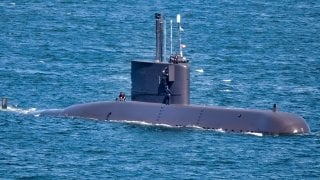A German U-Boat Just Traveled Where You Might Least Expect It
Germany's Technik Museum Sinsheim is set to showcase a retired German U-Boat, U17, joining its impressive collection of over 3,000 exhibits, including a Concorde and a Soviet-era Tupolev Tu-144.
Summary and Key Points: Germany's Technik Museum Sinsheim is set to showcase a retired German U-Boat, U17, joining its impressive collection of over 3,000 exhibits, including a Concorde and a Soviet-era Tupolev Tu-144.
-The U17, a Type 206 submarine, operated from 1973 until 2010 and undertook a challenging journey from the port of Hamburg to the museum, involving river transport and a 30-mile overland trip. This journey required careful navigation through narrow streets and under bridges, highlighting the logistical efforts involved.
-The U17's relocation adds another layer of historical significance to the museum, which also features the largest collection of Formula One race cars in Europe.
How A German Submarine Is Making a 'Move'
Germany's Technik Museum Sinsheim is already home to more than 3,000 exhibits including a former France Concorde and a Soviet-era Tupolev Tu-144 supersonic aircraft, the largest collection of Formula One race cars in Europe, and numerous military tanks. The museum will soon have a retired German U-Boat on display – which is all the more noteworthy because of where the Technik Museum Sinsheim is located.
The facility, in Baden-Württemberg, is about an hour and a half south of Frankfurt, and more than six hours from the port of Hamburg, which presented challenges in getting U-Boat U17 to the museum. The 350-tonne German Navy submarine, operated from 1973 until 2010, has slowly been making its final journey to the museum via rivers and roads.
After being moved on barge, on July 13, the submarine was put on a 30-axle low-loader and carefully driven to its new home, the museum announced in a post on X, the social media platform formerly known as Twitter.
While submarines can easily travel under the water – which obviously they are designed to do – there were "logistical challenges" that came with it being driven the 50 km (30 miles) on land, namely that it was too large to fit under several bridges. The 295-foot-long and 33-foot-tall boat had to be put on its side and then set upright again to squeeze through some of the narrow streets on the route to the museum.
As TheDrive reported, the straight shot would have been to take it on the Autobahn – cutting the distance down to 30 km (19 miles). However, the slightly longer route was chosen as it was more accessible for the U17.
"We have brought a fascinating exhibit to us in a large team in a spectacular transport," said project manager Michael Einkörn, a former submariner who will also give expert tours of the retired U-Boat at its new home.
The U17 was one of 18 Type 206 U-Boats designed to operate in the shallow Baltic Sea and constructed by Howaldtswerke-Deutsche Werft (HDW) for the Bundesmarine between 1969 and 1975. Though not employed in combat, the Type 206 boats are noteworthy for remaining in service for nearly four decades, longer than any other U-Boat.
Moreover, in 2001, the German Type 206 U24 was deployed to JTFEX 01-2 naval exercises in the Caribbean Sea and managed to break through all the security around the USS Enterprise (CVN-65). The submarine fired green flares and took photographs of the U.S. Navy's flattop, essentially "sinking it."
All have been retired from service with the modern Deutsche Marine, while two remain active with the Colombian Navy.
Slow Roll for German U-boat
When operational, the U17 was powered by two 4-stroke MTU 600-horsepower diesel-electric engines, and had a cruising speed of 10 knots surfaced and 17 knots submerged. For its final journey on the land, it moved far slower, taking nearly four weeks to travel the final distance to the museum.
The total cost of the move was estimated at around 2 million euros ($2.17 million), which was financed via donations. Even as the U17 has completed its trek, it will still be a year before it is on display. The submarine will be refurbished and painted, while it is on track to be on display next summer. The hardest part was simply getting it to the Technik Museum Sinsheim.
Peter Suciu is a Michigan-based writer. He has contributed to more than four dozen magazines, newspapers, and websites with over 3,200 published pieces over a twenty-year career in journalism. He regularly writes about military hardware, firearms history, cybersecurity, politics, and international affairs. Peter is also a Contributing Writer for Forbes and Clearance Jobs. You can follow him on Twitter: @PeterSuciu. You can email the author: [email protected].
All images are Creative Commons.


